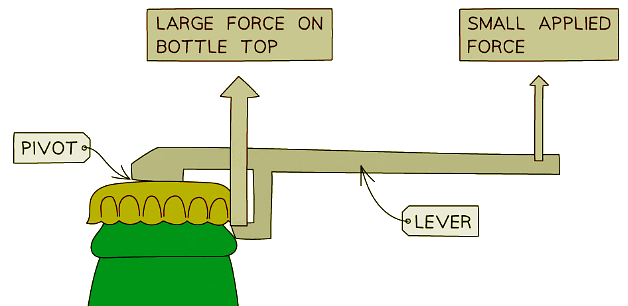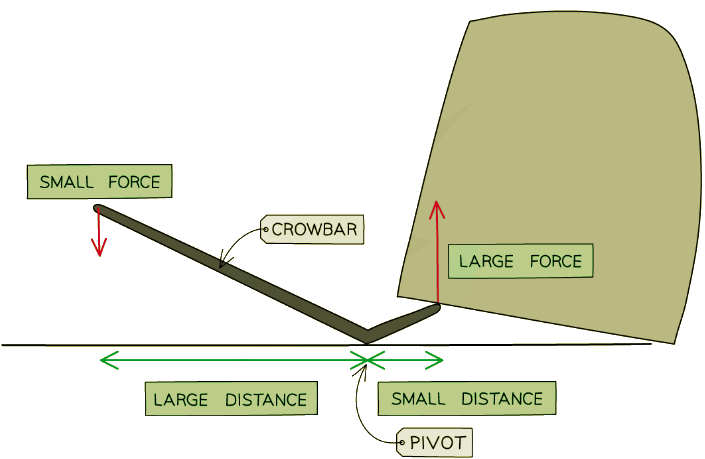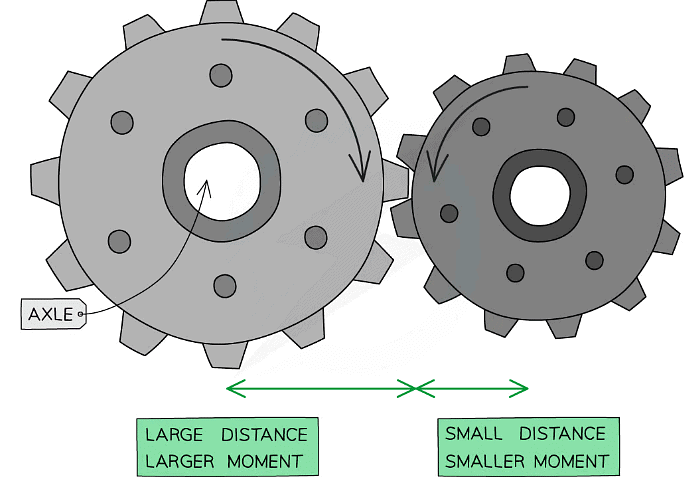Grade 10 Exam > Grade 10 Notes > Physics for Grade 10 > Levers & Gears
Levers & Gears | Physics for Grade 10 PDF Download
Introduction
- Both simple lever and gear systems can be used to transmit and amplify the rotational effects of forces
- This can be achieved using the concept of moments
Levers
- Levers increase the size of a force acting on an object to make the object turn more easily
- The force applied to a lever must act further from the pivot than the force has to overcome
- To make a lever work better:
- Increase the size of the force applied
- Increase the distance of the force from the pivot
- An example of a lever is a bottle opener
 Using a bottle opener to create a large force upwards on the bottle top
Using a bottle opener to create a large force upwards on the bottle top - A bottle opener uses a lever to amplify the small force upwards applied by the person to create a large force upwards on the bottle top to remove it
- The line of action of the small force is much further from the pivot than the large force that is needed at the edge of the cap to remove it
- The bottle opener (lever) makes use of moments to act as a force multiplier
- A crowbar is also a type of lever used to exert a large force to a narrow opening. This helps life heavy objects
- The small force downwards applied by a person is far away from the pivot
- This creates a large force upwards on the heavy object, making it easier to lift

Gears
- Gears, similar to levers, multiply the effect of a turning force using moments
- They consist of wheels with toothed edges that rotate on an axle or shaft, which acts as the pivot
- The teeth of one gear fit into the teeth of another gear
- This lets one gear turn the other, meaning one axle or shaft can be used to turn another shaft
- As one gear turns, the other must also turn
- Where the gears meet, the teeth will then move in the same direction (e.g. downwards)
- One of the gears will then move clockwise, and the other anticlockwise (in opposite directions)
- Although the force will be the same on both gears, the moment will not be. This depends on the size of the gear, which changes the distance of the teeth to the pivot (axle)
- If a larger gear is driven by a smaller gear, the large gear will rotate slower than the smaller gear but will have a greater moment. For example, a low gear on a bike or car
- If a smaller gear is driven by a larger gear, the smaller gear will rotate quicker than the larger gear but will have a smaller moment. For example, a high gear on a bike or cart
- This is because the turning force on the larger gear wheel acts further from its pivot than the turning force of the smaller gear wheel acting on its own pivot
 Two gears will rotate in opposite directions. A larger gear will have a larger moment
Two gears will rotate in opposite directions. A larger gear will have a larger moment
The document Levers & Gears | Physics for Grade 10 is a part of the Grade 10 Course Physics for Grade 10.
All you need of Grade 10 at this link: Grade 10
|
122 videos|150 docs|40 tests
|
Related Searches















